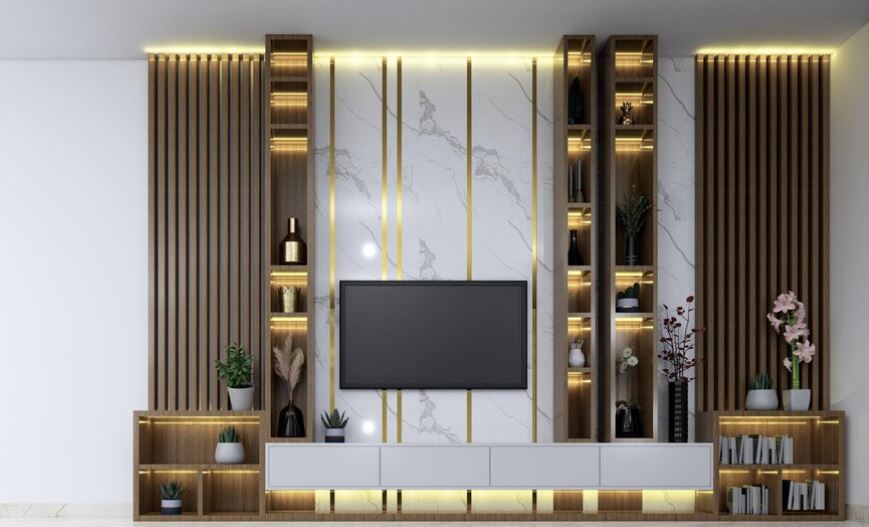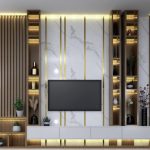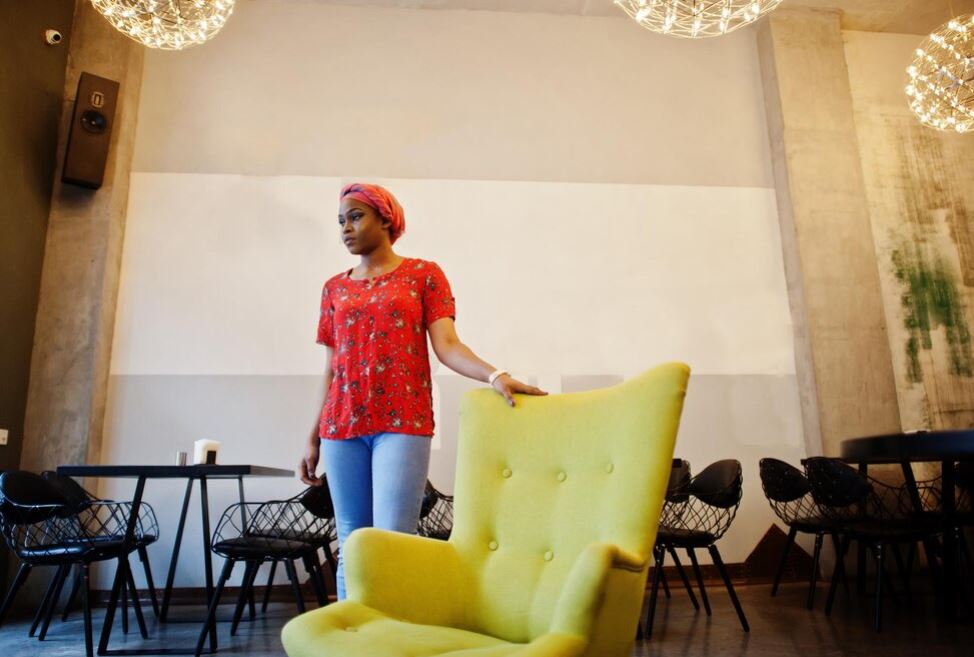
Introduction:
In Nigeria, interior design is not just about aesthetics; it’s a vibrant reflection of the nation’s soul. Join us as we embark on a journey through 10 Interior Design Styles in Nigeria, each a testament to the country’s rich tapestry of traditions and contemporary flair. Whether you’re a homeowner, a design enthusiast, or simply curious, this list post promises to reveal the heart and soul of Nigerian homes.
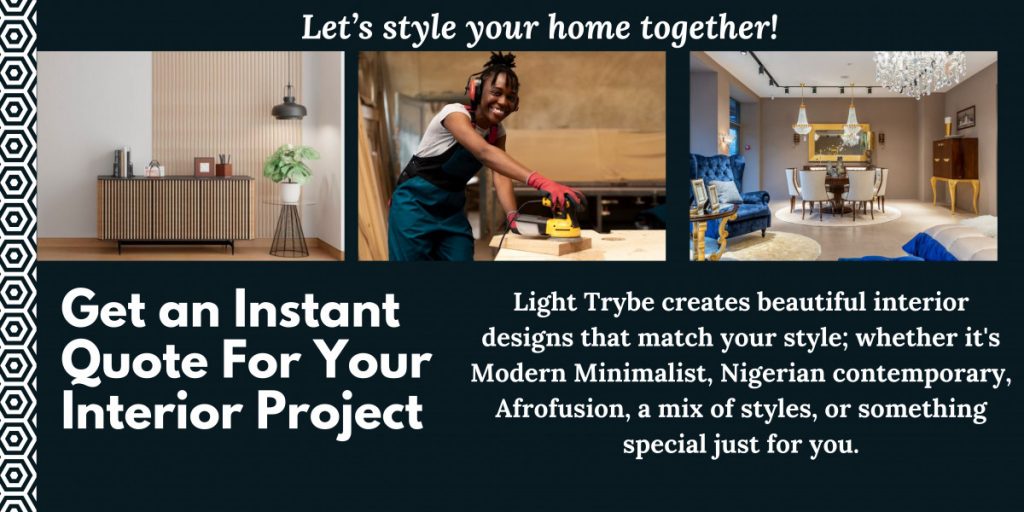
1. Contemporary Nigerian Style:

Characteristics:
Contemporary Nigerian style, often simply referred to as “Nigerian Contemporary,” is a design approach that skillfully blends modern elements with the rich cultural influences of Nigeria. It’s characterized by its ability to infuse the vibrancy of traditional Nigerian culture into a contemporary living space. Here are some key characteristics that define this style:
- Bold Color Palette: Contemporary Nigerian interiors often feature bold and warm color palettes. These colors draw inspiration from the Nigerian landscape, with shades of terracotta, deep reds, earthy browns, and vibrant yellows. These hues are balanced with neutral tones like whites and grays to create harmony.
- Traditional Patterns: To maintain a connection with Nigerian heritage, the contemporary Nigerian style incorporates traditional African patterns and motifs. These patterns are prominently seen in textiles, upholstery, and wall art. Geometric shapes, tribal prints, and Adire (a traditional Yoruba tie-dye fabric) are commonly used.
- Local Artwork and Crafts: Art is at the heart of Nigerian culture, and this style pays homage by integrating local artwork and crafts. Wooden carvings, sculptures, beadwork, and handwoven textiles become focal points in contemporary Nigerian interiors.
- Modern Furniture and Design Elements: While rooted in tradition, this style seamlessly incorporates modern furniture and design elements. Clean lines, minimalistic forms, and functional furniture pieces are carefully chosen to complement the overall aesthetic.
- Natural Materials: There’s a preference for natural materials like wood and stone, both for their sustainability and the warm, earthy textures they add to the space. Wooden furniture and stone accents are common features.
- Nigerian Accessories: To complete the look, accessories like decorative pottery, gourds, and locally made baskets are strategically placed throughout the home. These items not only contribute to the design but also reflect the richness of Nigerian craftsmanship.
Contemporary Nigerian style is an excellent choice for those who want to infuse their living spaces with a sense of cultural identity while still enjoying the benefits of modern design. It’s ideal for homeowners who:
- Have an appreciation for traditional Nigerian art and culture.
- Seek a harmonious balance between traditional and contemporary design elements.
- Want a home that reflects their Nigerian heritage and identity.
- Desire a bold and vibrant interior that exudes warmth and personality.
The Contemporary Nigerian style offers a unique opportunity to celebrate Nigeria’s rich cultural heritage within the context of modern living. It harmoniously combines bold colors, traditional patterns, local artwork, and modern design elements to create inviting and culturally rich interiors that resonate with the spirit of Nigeria.
2. Traditional Nigerian Style:
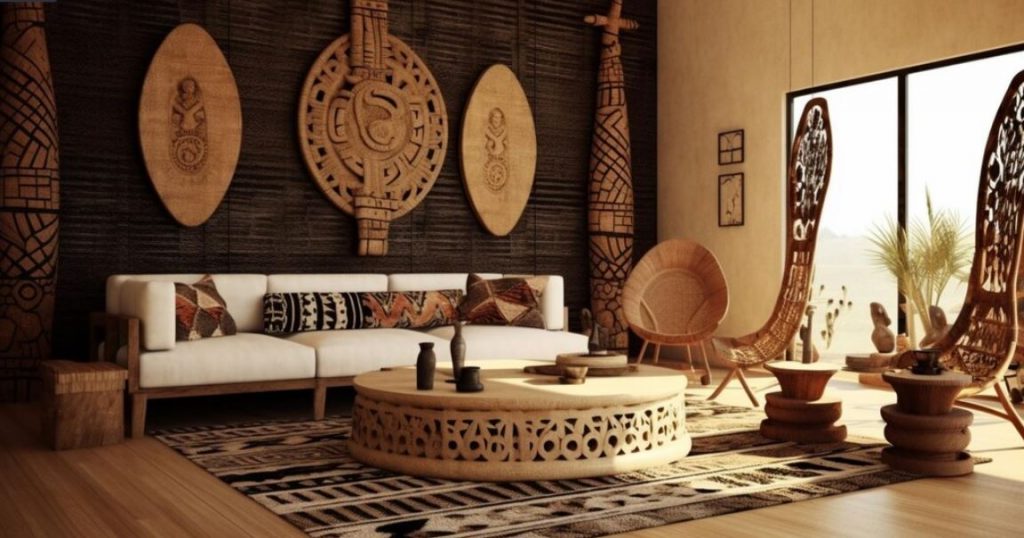
Characteristics:
Traditional Nigerian interior design draws deeply from the nation’s diverse cultural heritage, showcasing a rich tapestry of customs and artistic expressions. This style is a homage to the country’s history and traditions, celebrating its various ethnic groups such as the Yoruba, Igbo, and Hausa, each of which brings its own unique elements to the design.
Key Elements:
- Tribal Art and Sculptures: Traditional Nigerian homes often feature tribal masks, sculptures, and figurines as prominent decor elements. These pieces often represent ancestral spirits, and their presence imparts a sense of cultural richness.
- Woven Textiles and Fabrics: Traditional Nigerian textiles, like the popular Aso Oke and Adire, are used for upholstery, curtains, and throw pillows. These fabrics are known for their vibrant colors and intricate patterns, adding a burst of visual appeal to interiors.
- Intricate Carvings: Wooden carvings are an integral part of this style. You’ll find intricately carved wooden furniture, doors, and wall panels, showcasing both craftsmanship and storytelling.
- Natural Materials: Traditional Nigerian homes emphasize natural materials such as wood, clay, and mud. Mud walls, for instance, help maintain comfortable temperatures in harsh climates and contribute to the rustic charm of the space.
- Indigenous Pottery: Decorative pottery and ceramics, often handmade by local artisans, are displayed throughout the home. These items add an authentic touch and can be both functional and decorative.
- Color Palette: The color palette in traditional Nigerian design is often warm and earthy, reflecting the natural surroundings. Colors like terracotta, ochre, deep reds, and browns dominate, creating a cozy and inviting atmosphere.
- Thematic Layout: Homes in this style often have a layout that revolves around a central courtyard, an architectural feature reminiscent of traditional Nigerian compounds. This layout fosters a sense of community and family bonding.
Ideal for: Traditional Nigerian style is ideal for those who have a deep appreciation for the nation’s cultural heritage and want to create an interior that pays homage to its history. It’s especially well-suited for:
- Cultural Enthusiasts: Individuals who want to showcase the beauty of Nigeria’s diverse cultures and traditions within their living spaces.
- Art Collectors: Those who appreciate and collect tribal art and sculptures, as they seamlessly blend into this design style.
- Nature Lovers: People who prefer natural and sustainable materials in their homes.
- History Buffs: Individuals fascinated by the history and traditions of Nigeria and who wish to keep them alive through their living spaces.
- Fans of Rustic Charm: Anyone who enjoys the warm and cozy aesthetics of rustic interiors, complete with wooden furniture and earthy color schemes.
Incorporating traditional Nigerian style into your home is a way of preserving the nation’s cultural identity and creating a unique, inviting, and deeply meaningful living space that connects you to Nigeria’s rich heritage.
3. Afrocentric Style:
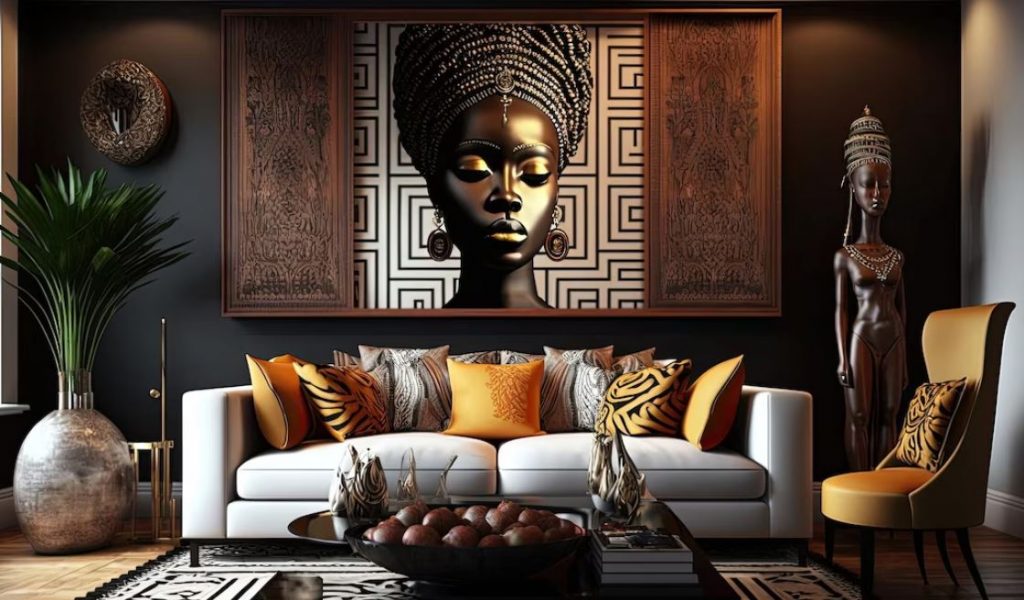
Characteristics:
Afrocentric interior design is a celebration of African culture and heritage. It’s a style that draws inspiration from the diverse traditions, art, and aesthetics of the African continent. In Nigeria, Afrocentric design reflects the nation’s own cultural diversity, making it a popular choice for those who want their homes to be a vibrant showcase of Africa’s many facets.
Key Elements:
- African Textiles: One of the defining features of Afrocentric design is the use of African textiles. Fabrics like Ankara, Kente, and Adire are commonly incorporated into upholstery, throw pillows, curtains, and even wall hangings. These fabrics are known for their bold and colorful patterns, often featuring geometric shapes and tribal motifs.
- Tribal Motifs: Afrocentric design often incorporates tribal motifs and symbols. These can be found in artwork, sculptures, and even on furniture. These motifs not only add visual interest but also carry cultural significance, telling stories of the past.
- Earthy Tones: While Afrocentric design embraces a wide range of colors, it often includes earthy tones like deep browns, rich reds, and warm oranges. These colors evoke a sense of the African landscape and create a cozy, inviting atmosphere.
- Handcrafted Decor: Handcrafted items play a significant role in Afrocentric interiors. This includes handmade pottery, wooden carvings, and beaded accessories. These pieces add a sense of authenticity and craftsmanship to the space.
- Natural Materials: Natural materials like wood, stone, and bamboo are commonly used in Afrocentric design. They connect the interior to the natural world and provide a warm and organic feel to the space.
Ideal for: Afrocentric style is ideal for those who have a deep appreciation for African culture and want their homes to reflect this passion. It’s also a popular choice among the African diaspora, as it allows individuals to stay connected to their roots and celebrate their heritage.
Tips for Achieving Afrocentric Design:
- Start with Fabrics: Consider incorporating African textiles into your space through throw pillows, upholstery, or even drapes. These textiles can serve as a vibrant focal point.
- Tribal Art and Decor: Look for art pieces and decor items that feature tribal motifs. These can be framed artworks, sculptures, or even decorative masks.
- Natural Elements: Use natural materials for furniture and decor. Wooden furniture, stone sculptures, and bamboo accessories can infuse your space with an authentic African feel.
- Earthy Color Palette: Embrace earthy tones and warm colors for your walls and larger furniture pieces. These colors complement the vibrant patterns of African textiles.
- Personal Touch: Don’t be afraid to add your personal touch to the design. Mix and match patterns and textiles to create a unique and personalized Afrocentric space.
Incorporating Afrocentric design into your home is a wonderful way to celebrate African culture and infuse your living space with a sense of warmth, vibrancy, and cultural richness. Whether you’re of African descent or simply appreciate the beauty of African aesthetics, this style can create a captivating and inviting home environment.
4. Nigerian Minimalism:
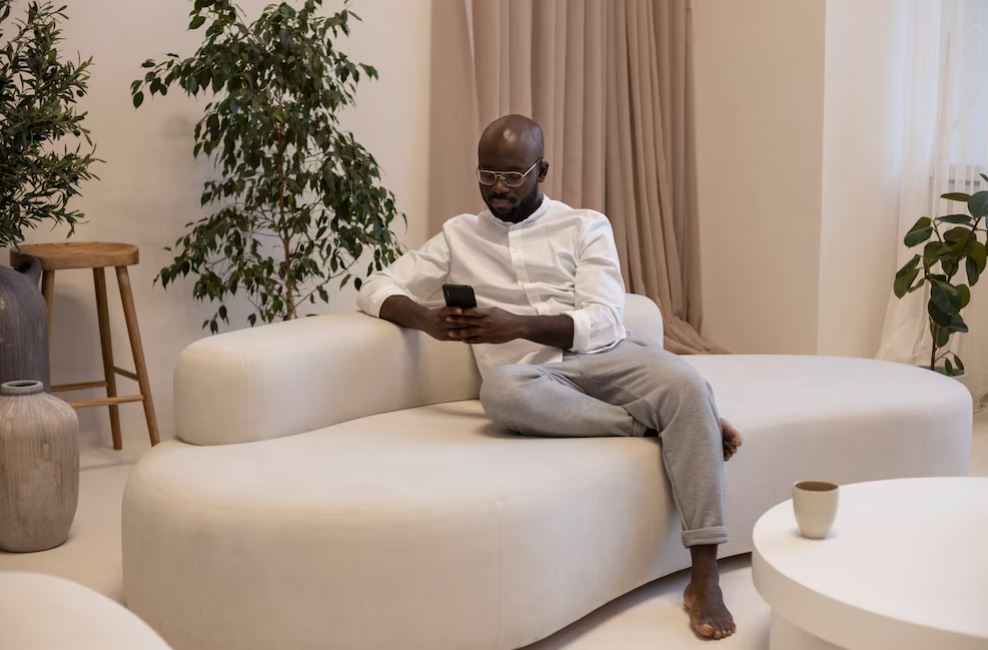
Characteristics:
Nigerian Minimalism is an interior design style that has gained popularity for its clean, uncluttered, and serene aesthetics. It revolves around the principle of “less is more” and emphasizes simplicity and functionality. Here’s a more detailed look at the characteristics of Nigerian Minimalism:
- Neutral Color Palette: The color scheme is typically dominated by neutral tones such as whites, grays, beige, and muted earthy colors like taupe and olive green. These colors create a sense of calm and openness in the space.
- Clean Lines: Furniture and decor in Nigerian Minimalism feature clean and straight lines. Angular shapes are preferred over ornate and intricate designs. This simplicity promotes a sense of order and tidiness.
- Clutter-Free Spaces: Minimalism places a strong emphasis on decluttering. Personal items and unnecessary decor are kept to a minimum. Storage solutions are often integrated into the design to keep everyday items out of sight.
- Functional Furniture: Furniture pieces are chosen for their functionality and practicality. Multi-purpose furniture, such as storage ottomans or foldable tables, is commonly used to maximize space.
- Natural Light: Nigerian Minimalism leverages natural light to its advantage. Large windows and open layouts are favored to bring in as much sunlight as possible. Window treatments are often minimal, like sheer curtains, to allow for unobstructed views and light.
- Quality over Quantity: Rather than filling a space with numerous items, Nigerian Minimalism emphasizes the quality of each piece. High-quality materials and craftsmanship take precedence, ensuring that the chosen furniture and decor pieces are long-lasting and timeless.
Key Elements:
- Sleek Furniture: Minimalist furniture features clean and sleek designs. Common furniture pieces include low-profile sofas, simple dining tables, and unadorned storage units. The focus is on functionality and visual simplicity.
- Minimal Decor: Wall art and decor are kept minimal, with a few carefully chosen pieces that complement the overall design. Large, unframed artwork or a single statement piece might be used to create a focal point.
- Decluttered Surfaces: Countertops, tables, and shelves are kept clear of unnecessary items. Items that remain on display are often practical and aesthetically pleasing, such as a few well-chosen books or decorative vases.
- Efficient Storage: Storage solutions are integrated seamlessly into the design. This includes built-in cabinets, floating shelves, and concealed storage options to keep belongings organized and out of sight.
Ideal for: Nigerian Minimalism is ideal for individuals who appreciate simplicity, value functionality, and prefer an uncluttered living environment. It’s particularly well-suited for:
- Small Spaces: Minimalism’s focus on efficient use of space makes it perfect for smaller homes and apartments, as it can make rooms appear larger and airier.
- Busy Professionals: Those with busy lifestyles often find Nigerian Minimalism appealing because it reduces the time and effort needed for cleaning and maintenance.
- Peaceful Retreats: The serene and clutter-free environment created by this style can turn homes into tranquil retreats, promoting relaxation and mindfulness.
Nigerian Minimalism is a design style that celebrates simplicity and functionality. It’s about creating a serene and uncluttered living space where every element serves a purpose. Whether you have a small apartment or a spacious home, this style can help you achieve a clean, calming, and aesthetically pleasing interior.
5. Nigerian Eclectic Style:
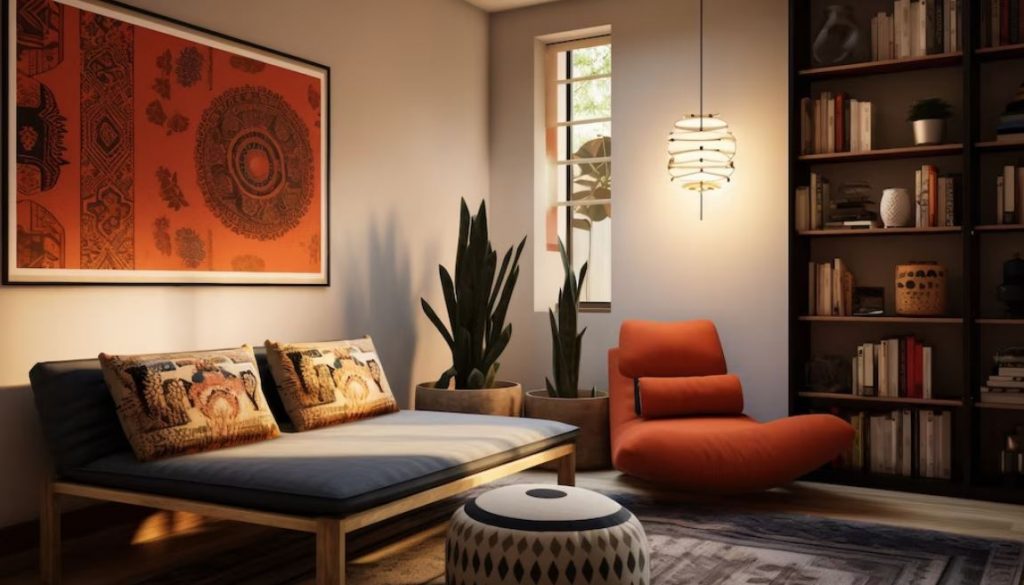
Nigerian eclectic style is a captivating fusion of various design elements, offering an exciting and personalized approach to interior design. It’s all about combining different styles, textures, and colors to create a space that’s vibrant, dynamic, and uniquely yours. Here’s a more detailed look at what defines this style and how you can achieve it in your own home:
Characteristics of Nigerian Eclectic Style:
- Mix of Styles: At its core, eclectic design thrives on the harmonious combination of diverse styles. In the Nigerian context, this might involve blending traditional African elements with modern or international aesthetics.
- Diverse Patterns and Textures: Expect an array of patterns and textures, from bold African prints to contemporary geometric shapes. The juxtaposition of different textures adds depth and visual interest to the space.
- Vibrant Color Palette: Eclectic interiors often embrace a bold and vibrant color palette. In Nigerian eclectic style, you can incorporate earthy tones inspired by the landscape, alongside pops of bright colors from African textiles or artwork.
- Mix-and-Match Furniture: Don’t be afraid to mix furniture styles from various eras and cultures. An antique wooden coffee table might sit next to a sleek, modern sofa, creating a visually stimulating contrast.
- Art and Accessories: Eclectic spaces are ideal for showcasing art and accessories collected from your travels or local artisans. African sculptures, tribal masks, or contemporary artwork can all find their place here.
Tips for Achieving Nigerian Eclectic Style:
- Start with a Neutral Base: To avoid overwhelming your space, begin with a neutral base color for your walls, floors, and larger furniture pieces. This provides a balanced backdrop for the eclectic elements.
- Select a Focal Point: Choose a focal point for each room, whether it’s a striking piece of artwork, a unique piece of furniture, or a vibrant rug. Build the room’s eclectic elements around this focal point.
- Layer Textures: Incorporate a variety of textures through textiles, such as woven rugs, plush cushions, and tactile wall hangings. This adds depth and warmth to the space.
- Balance Bold with Subtle: While bold colors and patterns are key elements of Nigerian eclectic style, balance them with more subtle or neutral pieces to create a cohesive look. Too much of a good thing can be overwhelming.
- Embrace Local Artisans: Support local artisans and craftsmen by incorporating handmade decor and furnishings into your design. This not only adds authenticity but also contributes to the local economy.
- Personalize with Your Story: Your eclectic space should tell a story about your travels, interests, and experiences. Mix in pieces that have sentimental value or cultural significance to make your home uniquely yours.
In Nigerian eclectic style, creativity knows no bounds. It’s an opportunity to infuse your personality into your living space, celebrating the rich tapestry of cultures and design elements that inspire you. With a thoughtful approach to mixing and matching, you can create a home that’s as unique and vibrant as Nigeria itself.
6. Islamic Influence:
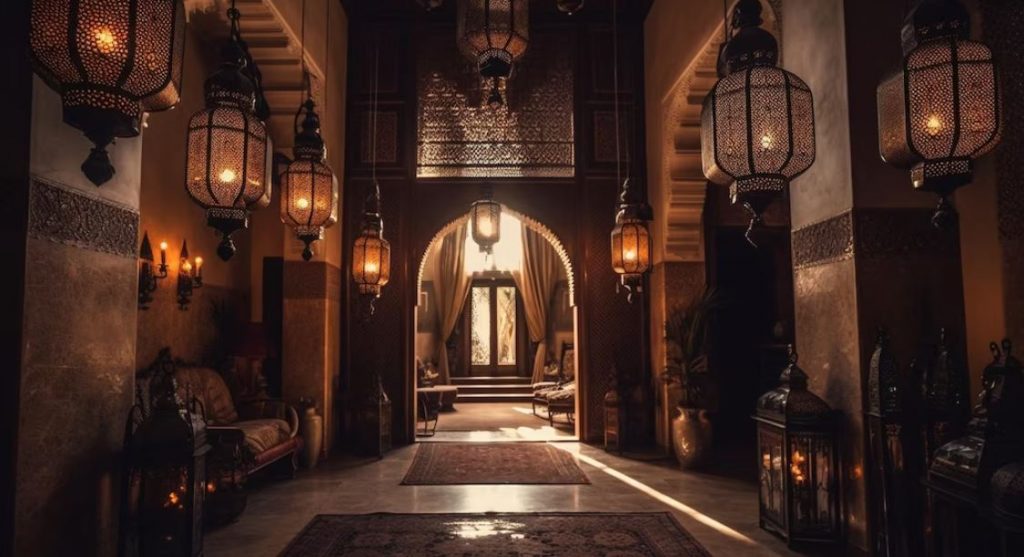
Nigeria, with its rich cultural tapestry, is home to diverse religious and ethnic groups, including a significant Muslim population. This Islamic influence is beautifully expressed in interior design, adding an element of elegance and spirituality to homes. Here’s a more detailed exploration of Islamic design elements in Nigerian interiors:
Characteristics:
- Geometric Patterns: Islamic interior design often features intricate geometric patterns. These patterns, known as “zillij” or “arabesque,” adorn various surfaces like walls, ceilings, and floors. They create a sense of harmony and balance within the space.
- Arabesque Motifs: Arabesque motifs, characterized by scrolling and interlacing floral and geometric designs, are a hallmark of Islamic decor. You’ll find these motifs in decorative elements like furniture, lamps, and textiles.
- Rich Textiles: Islamic-influenced interiors in Nigeria often incorporate rich and luxurious textiles. Persian rugs, silk curtains, and ornate upholstery with intricate designs and calligraphy are common.
- Intricate Tile Work: Tiled surfaces, especially mosaic tile work, are a prominent feature in Islamic interior design. These tiles may display geometric patterns or verses from the Quran, adding both aesthetic and spiritual significance.
Key Elements:
- Ornate Lighting: Lighting fixtures play a crucial role in Islamic design. Exquisite chandeliers with intricate metalwork and colored glass are popular choices. The soft, warm light creates a tranquil ambiance.
- Majlis Seating: In some Nigerian homes, you’ll find a dedicated seating area inspired by the Middle Eastern “majlis.” These spaces feature low, cushioned seating arranged around a central coffee table, fostering conversation and relaxation.
- Calligraphy and Art: Arabic calligraphy, often featuring verses from the Quran or other meaningful texts, can be seen in framed artworks, wall hangings, or even incorporated into architectural elements like arches.
- Use of Natural Materials: Islamic design places a strong emphasis on natural materials like wood, stone, and marble. These materials are often intricately carved or engraved with Islamic patterns.
Ideal for:
- Homes with a Spiritual Focus: Islamic-influenced design is ideal for homes where the residents value their Islamic faith and want their living spaces to reflect their spirituality.
- Elegance and Sophistication: The intricate details and rich textures of Islamic design add an air of opulence and refinement to any space.
- Cultural Appreciation: For those who appreciate the art and culture of Islamic societies, incorporating Islamic design elements is a way to celebrate this rich heritage.
Islamic influence in Nigerian interior design is a testament to the country’s diverse cultural landscape. It brings a sense of spirituality, elegance, and cultural appreciation into homes. Whether you incorporate Islamic design elements subtly or prominently, they can significantly enhance the aesthetics and atmosphere of your living spaces, creating an environment that is both visually striking and spiritually meaningful.
9. Rustic Nigerian Style:
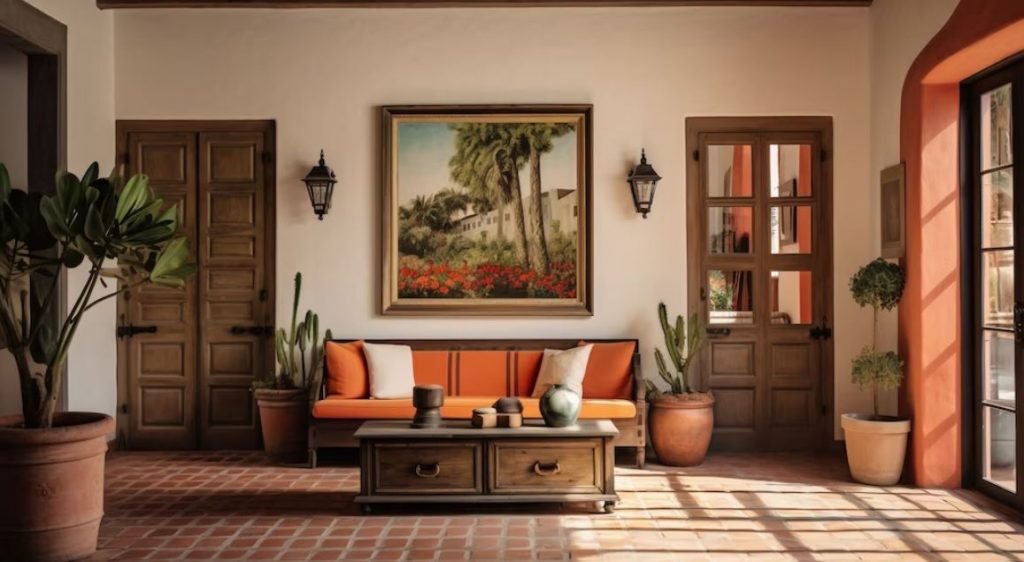
Nigeria’s rural areas are teeming with natural beauty and age-old traditions. Rustic Nigerian style takes inspiration from these landscapes and cultures to create interiors that are down-to-earth, warm, and full of character.
Characteristics:
- Natural Materials: Rustic Nigerian style places a strong emphasis on natural materials like wood, stone, and clay. These materials bring an authentic, earthy feel to the space.
- Earthy Color Palette: The color scheme is typically warm and earthy, featuring shades of brown, terracotta, deep reds, and greens. These colors mimic the colors of Nigeria’s landscapes.
- Exposed Elements: This style often exposes architectural elements like wooden beams or brick walls, celebrating the structural integrity of the space.
- Traditional Pottery: Decorative pottery, such as intricately designed clay pots and vases, adds a touch of Nigerian tradition and craftsmanship to the decor.
- Handcrafted Furniture: Furniture in rustic Nigerian interiors is often handmade and can include wooden tables, chairs, and benches. These pieces showcase local craftsmanship and artistry.
- Textiles: Traditional Nigerian textiles, like woven fabrics and patterned textiles, are incorporated into the decor as throws, cushions, or even wall hangings.
Key Elements:
- Mud Houses Inspiration: The architectural style might draw inspiration from traditional Nigerian mud houses, with mud or clay walls that create a unique texture and warmth.
- Natural Lighting: Maximizing natural light is important in rustic Nigerian interiors. Large windows and openings allow sunlight to flood the space during the day.
- Indigenous Art: Incorporating indigenous artwork and sculptures that reflect Nigerian culture and history adds authenticity to the design.
Ideal for:
- Nature Lovers: Rustic Nigerian style is ideal for those who appreciate the beauty of the natural world and want to bring elements of it indoors.
- Cultural Enthusiasts: If you have a passion for Nigerian culture and traditions, this style allows you to showcase them in your living spaces.
- Comfort Seekers: Rustic interiors exude warmth and coziness, making them perfect for people who want a comfortable and inviting home.
Creating Your Rustic Nigerian Interior:
- Start with the Basics: Begin by selecting natural materials for your floors, walls, and ceilings. Exposed wooden beams and brickwork can be striking focal points.
- Choose Earthy Colors: Opt for a warm color palette inspired by Nigerian landscapes. Deep browns, terracotta, and greens can be dominant colors.
- Handcrafted Furniture: Look for locally crafted wooden furniture pieces. These can include dining tables, chairs, and cabinets.
- Textile Accents: Add pops of color and pattern with traditional Nigerian textiles, such as Aso Oke, adire, or Ankara fabrics, which can be used for cushions, throws, or even curtains.
- Pottery and Artwork: Decorate with handmade pottery and indigenous artwork that tells a story about Nigerian heritage.
- Natural Lighting: Maximize natural light through strategically placed windows and consider using warm, ambient lighting to create a cozy atmosphere during the evenings.
Rustic Nigerian style is about embracing the beauty of nature and culture in your home. By incorporating natural elements, traditional craftsmanship, and warm colors, you can create a truly inviting and soulful living space that reflects the essence of rural Nigeria.
8. Urban Contemporary:
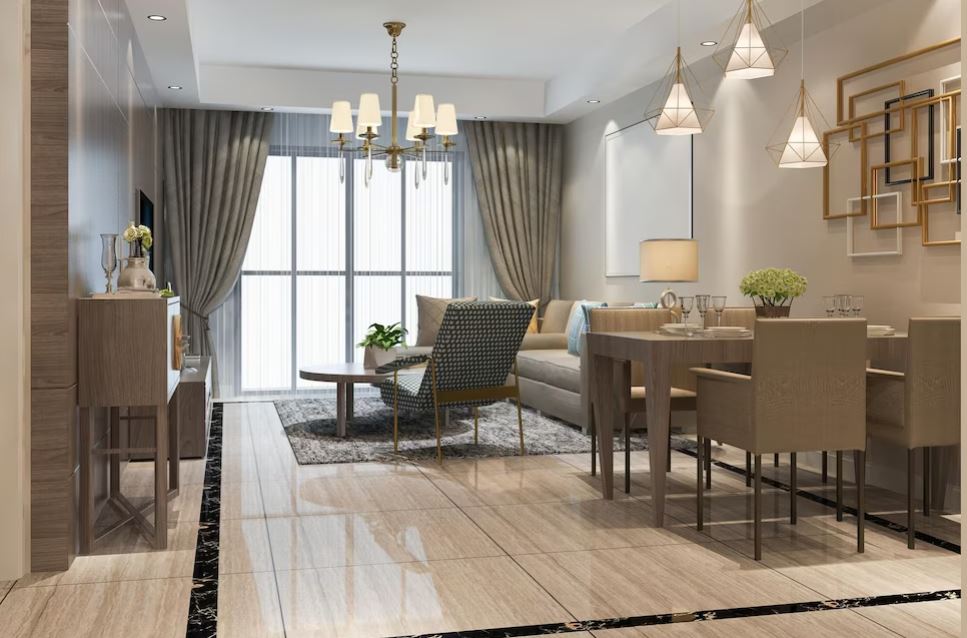
Nigeria’s rapidly growing urban areas, such as Lagos and Abuja, have given rise to a unique interior design style known as Urban Contemporary. This style beautifully blends modern aesthetics with the fast-paced, cosmopolitan lifestyle of the urban Nigerian. If you’re looking to infuse your living space with sophistication and the spirit of city living, Urban Contemporary design might be your ideal choice.
Characteristics:
- Sleek and Clean Lines: Urban Contemporary design is characterized by clean, straight lines in furniture, architecture, and decor. This creates an uncluttered and visually appealing environment.
- Neutral Color Palette: The color scheme often revolves around neutral tones like whites, grays, and blacks. These colors create a sense of openness and sophistication.
- Open Spaces: Open floor plans and minimalist design contribute to a sense of spaciousness, making the most of limited urban living spaces.
- High-end Materials: Premium materials like marble, granite, glass, and metal accents are commonly used to add luxury and elegance to the interiors.
- Statement Lighting: Unique and stylish lighting fixtures become focal points in Urban Contemporary design, adding both functionality and artistry to the space.
- Contemporary Furniture: Furniture pieces are chosen for their modern design and functionality. You’ll find sleek sofas, minimalist coffee tables, and designer chairs that contribute to the overall aesthetic.
- Minimal Decor: Decorative elements are kept to a minimum to maintain the clean and uncluttered look. A carefully selected piece of art or a standout accessory might be the only decorative item in a room.
- Incorporation of Technology: Smart home features, such as integrated sound systems and automated lighting, are common in urban contemporary interiors.
Ideal for:
- City Dwellers: Urban Contemporary design is ideal for those living in Nigeria’s bustling urban centers. It complements the fast-paced city lifestyle and makes the most of smaller living spaces.
- Minimalists: If you appreciate the simplicity and functionality of a minimalist approach to design, this style can help you create a serene and clutter-free living space.
- Tech Enthusiasts: With its emphasis on modernity, Urban Contemporary design suits individuals who enjoy incorporating the latest technology into their homes.
Tips for Achieving Urban Contemporary Design:
- Neutral Foundation: Start with a neutral color palette for walls and large furniture pieces. Whites, grays, and muted tones create a timeless base.
- Furniture Selection: Invest in contemporary and high-quality furniture pieces with clean lines. Look for multifunctional furniture to maximize space.
- Statement Lighting: Choose unique and stylish lighting fixtures that reflect your personal style. Pendant lights and modern chandeliers can become eye-catching focal points.
- Open Layout: If possible, consider open floor plans to create a sense of space. Use area rugs to define different functional areas within the open layout.
- Minimal Decor: Be selective with decor items. A single, well-chosen piece of art or a carefully curated collection can add character without overwhelming the space.
- Smart Home Integration: Explore smart home technologies for added convenience and functionality.
Incorporating Urban Contemporary design into your home in Nigeria can bring a touch of sophistication and modernity to your urban lifestyle. It’s a style that celebrates the simplicity, functionality, and elegance of city living, making it a popular choice for those seeking a chic and cosmopolitan interior ambiance.
9. African Modernism:
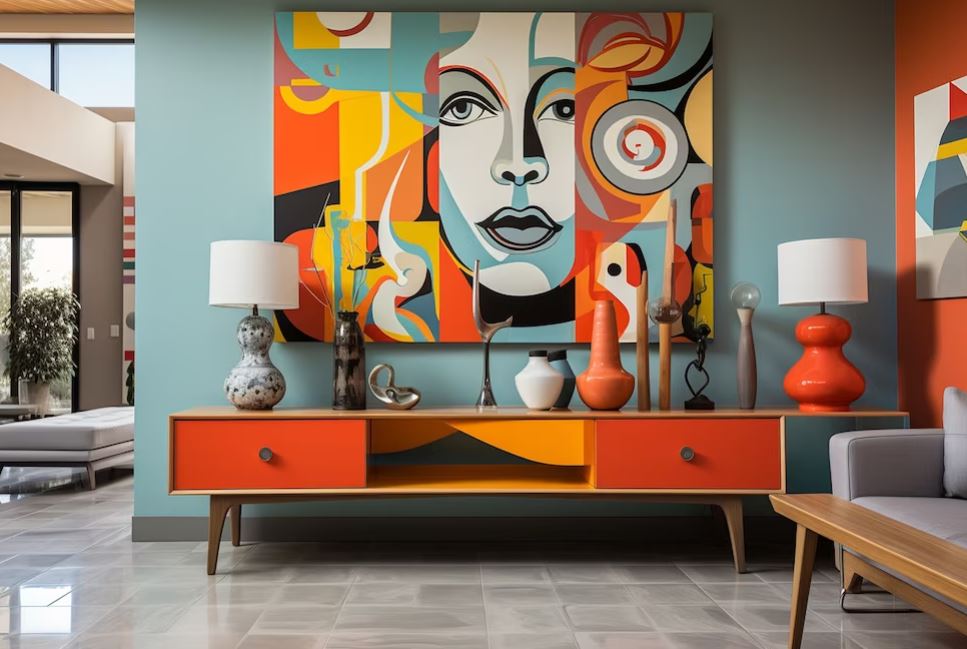
Characteristics:
African modernism is a captivating interior design style that seamlessly blends contemporary design elements with a strong African identity. This style is characterized by its ability to infuse modern living spaces with the rich cultural and artistic heritage of Africa. Here are some key characteristics that define African modernism:
- Bold African Prints: African modernism often incorporates vibrant and bold African prints into upholstery, curtains, cushions, and even wall art. These prints, such as Ankara or Kente, bring a burst of color and energy to the space.
- Wooden Furniture: Wooden furniture is a staple in African modernism. Dark, rich wood tones are commonly used for tables, chairs, cabinets, and other furnishings. These pieces often feature intricate carvings or traditional African motifs.
- Locally Sourced Materials: Sustainability is a significant aspect of African modernism. Many designers in Nigeria opt for locally sourced materials, promoting the use of indigenous wood, stones, and sustainable resources in their designs.
- Tribal Art and Sculptures: Authentic tribal art pieces and sculptures are prominently displayed as statement pieces in African modernist interiors. These pieces not only showcase the artistic heritage of Africa but also add a touch of authenticity to the space.
- Earthy Color Palettes: While bold colors are prevalent in textiles and artwork, the overall color palette tends to be earthy and warm. Shades of browns, oranges, deep reds, and greens create a cozy and inviting atmosphere.
- Handcrafted Decor: Handcrafted decor items, such as woven baskets, pottery, and beadwork, are often used as decorative elements. These pieces not only contribute to the authenticity of the space but also support local artisans.
- Minimalistic Approach: Despite the use of vibrant colors and patterns, African modernism often maintains a minimalistic approach to interior design. This means that the design elements are thoughtfully curated, ensuring that each piece has a purpose and contributes to the overall aesthetic.
- Natural Textures: African modernist interiors frequently incorporate natural textures like sisal rugs, cowhide, and woven materials. These textures add depth and tactile appeal to the design.
Ideal for:
African modernism is an ideal choice for individuals who want to celebrate their African heritage and create a contemporary living space that reflects their cultural identity. It’s also suitable for those who appreciate the use of sustainable materials and support for local artisans.
African modernism is a captivating interior design style that beautifully marries contemporary aesthetics with the rich artistic heritage of Africa. By incorporating bold prints, wooden furniture, locally sourced materials, and tribal art, homeowners in Nigeria and beyond can create living spaces that are not only visually stunning but also deeply meaningful, reflecting a connection to the continent’s diverse and vibrant cultures. Whether you want to infuse your home with African modernism entirely or just add a touch of this style, it’s a design choice that brings both character and soul to your living spaces.
10. Nigerian Fusion:
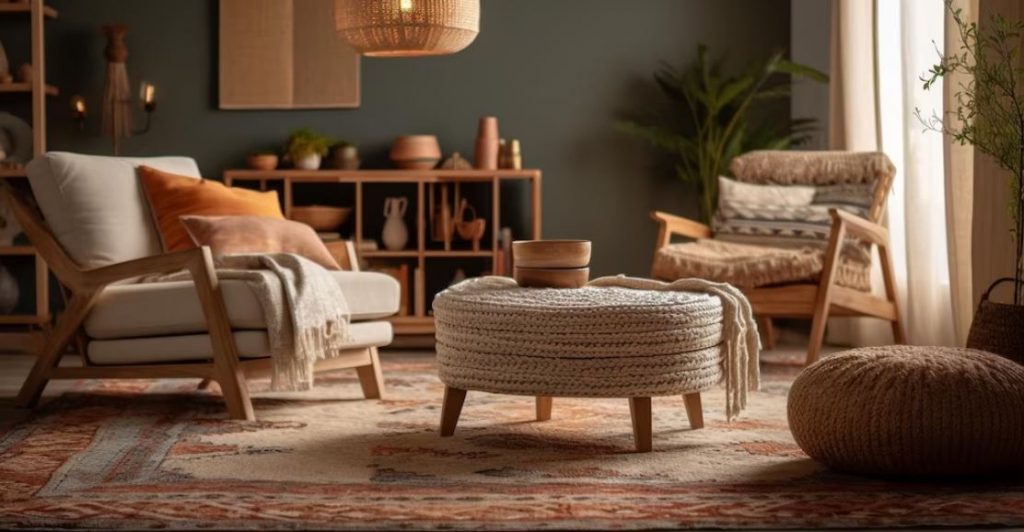
Nigerian Fusion interior design style is a captivating approach that draws inspiration from various cultures and design elements, resulting in truly unique and eclectic living spaces. This style celebrates diversity and allows homeowners to create interiors that are a reflection of their own personal experiences and tastes. Here’s a closer look at Nigerian Fusion and how to achieve it in your home:
Characteristics:
- Cultural Fusion: Nigerian Fusion embraces a melting pot of influences, combining elements from different cultures, both local and international.
- Global Textiles: Incorporating textiles from various regions, such as Moroccan rugs, Indian fabrics, and West African textiles, adds vibrancy and warmth to spaces.
- Mix of Materials: A hallmark of this style is the use of a variety of materials, including wood, metal, stone, and glass, to create a harmonious blend of textures.
- Diverse Colors: Embrace a broad color palette, from earthy tones to vibrant hues, to create a visually stimulating and culturally rich atmosphere.
Key Elements:
- Furniture: Mix and match furniture pieces from various design traditions. For example, pair a modern sofa with a vintage, hand-carved coffee table.
- Textiles: Layer different textiles like Persian rugs, African mud cloths, and silk throw pillows to infuse character and warmth into your space.
- Art and Decor: Incorporate diverse artwork and decor items from around the world. African masks, Asian ceramics, and European paintings can coexist beautifully.
- Lighting: Choose unique and culturally inspired lighting fixtures, like Moroccan lanterns or Japanese paper lamps, to create focal points.
- Wall Treatments: Experiment with textured wall treatments, such as reclaimed wood panels, intricate tile work, or global-inspired wallpapers.
Creating Your Nigerian Fusion Interior:
- Collect Inspiration: Start by gathering inspiration from design magazines, travel experiences, and online platforms like Pinterest. Create a mood board to visualize the elements you’d like to incorporate.
- Balance is Key: While the Nigerian Fusion style celebrates diversity, maintaining a sense of balance and cohesion is crucial. Ensure that the different elements complement each other rather than clash.
- Personalize: Infuse your personality and experiences into the design. Display souvenirs from your travels or heirlooms that hold sentimental value.
- Experiment with Layout: Don’t be afraid to experiment with furniture layouts. Mix up seating arrangements and create cozy nooks that invite conversation.
- Cultural Storytelling: Use your decor to tell a story. Each piece should have meaning and contribute to the narrative of your home.
- Seek Professional Advice: If you’re unsure about combining diverse elements, consider consulting with an interior designer who specializes in fusion styles. They can offer valuable insights and guidance.
Conclusion:
Nigerian Fusion interior design is a celebration of cultural diversity and personal expression. It allows you to create a home that reflects your unique experiences and tastes while honoring the beauty of different design traditions. Embrace the richness of Nigerian Fusion, and let your home become a canvas for your global inspirations and creative spirit.
In the world of interior design, Nigeria stands out as a treasure trove of inspiration and creativity. Its diverse range of styles reflects the rich tapestry of its culture, history, and people. Whether you’re drawn to the contemporary vibrancy of Nigerian urban life, the timeless elegance of tradition, or the fusion of cultures that defines this nation, there’s a design style to match every taste and personality.
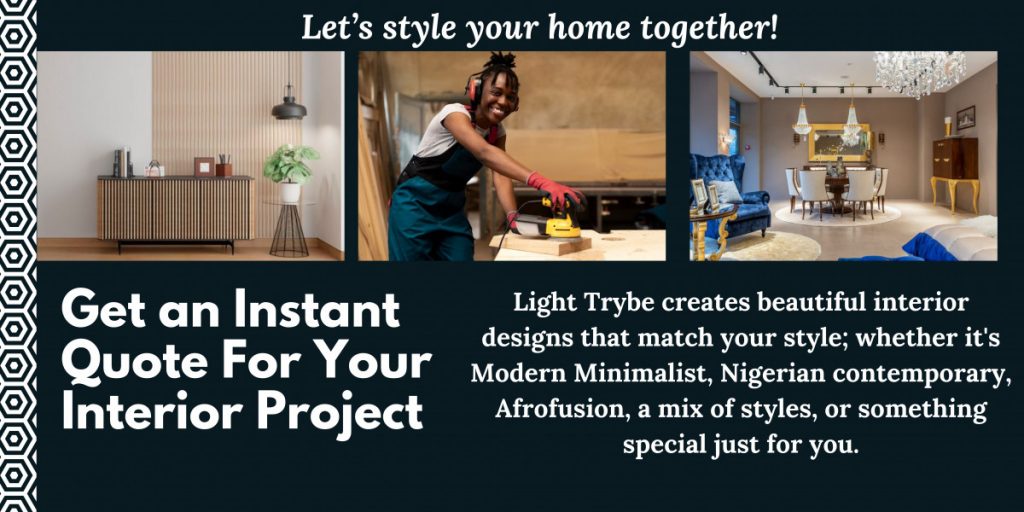
At Light Trybe, we understand the importance of finding the perfect interior design style to transform your living space into a place you truly cherish. Our network of diverse and talented interior designers is here to help you realize your vision. Whether you seek to infuse your home with traditional charm, modern sophistication, or a unique fusion of styles, we have the experts who can make it happen.
Your journey to creating the home of your dreams begins here. Explore the wonders of Nigerian interior design, and when you’re ready to turn your vision into reality, reach out to Light Trybe. Let us connect you with the perfect interior designer who will transform your living space into a masterpiece that reflects your style and personality.
Your dream home is just a click away. Contact Light Trybe today and let the magic of Nigerian interior design unfold in your living spaces. Together, we’ll create a home that truly speaks to your heart.



